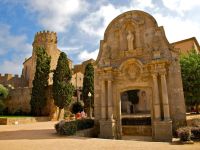
1. Monastery by the sea
The Benedictine Monastery is the most important heritage site in the town. It preserves important features such as its 10th century Romanesque Porta Ferrada, which has become a symbol. Mare de Déu dels Àngels church and Fum and Corn towers are also part of the building, which will house the Carmen Thyssen-Bornemisza Art Collection in a future.
The Monastery is a Cultural Feature of National Interest. The fortified Benedictine monastery dates back to the 10th century (Porta Ferrada) and was originally built over previous Roman structures, documented by archaeologists.
This monastery has different project stages until the 18th century, with the large baroque building.
The Arc de Sant Benet is an example of Baroque construction from the 18th century that was the old entrance to the monastic compound. In it we can see the coat of arms of the Monastery and the sculpture of the Saint. The original image was destroyed in 1936 and in 1999 it was replaced by a work by the sculptor Domènec Fita.
Sant Feliu de Guíxols grew up around the monastery and was developed later at the other bank of the Monastery stream. The town struggled to break free from the abbots’ feudal ambitions.
Apart from the monastery, the history of the town left an important architectural heritage, which was based on the cork industry. We find examples such as the Modernist houses on Sant Pol beach or the stately homes at the seafront promenade, like Casino La Constància, Sant Elm Hermitage because of its spectacular viewpoint over the Costa Brava, from where Ferran Agulló named the coast, and also the Sea Rescue Museum.












